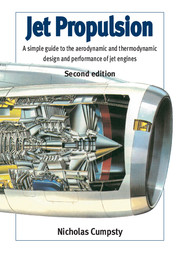 Jet Propulsion
Jet Propulsion Book contents
- Frontmatter
- Contents
- Preface
- Glossary
- Nomenclature
- Part 1 Design of Engines for a New 600-seat Aircraft
- Part 2 Engine Component Characteristics and Engine Matching
- Part 3 Design of Engines for a New Fighter Aircraft
- 13 A New Fighter Aircraft
- 14 Lift, Drag and the Effects of Manoeuvring
- 15 Engines for Combat Aircraft
- 16 Design Point for a Combat Engine
- 17 Combat Engines Off-design
- 18 Turbomachinery for Combat Engines
- Part 4 Return to the Civil Transport Engine
- Appendix: Noise and its Regulation
- Bibliography
- References
- Index
- Design sheets for New Large Civil Aircraft and New Fighter Aircraft
18 - Turbomachinery for Combat Engines
from Part 3 - Design of Engines for a New Fighter Aircraft
- Frontmatter
- Contents
- Preface
- Glossary
- Nomenclature
- Part 1 Design of Engines for a New 600-seat Aircraft
- Part 2 Engine Component Characteristics and Engine Matching
- Part 3 Design of Engines for a New Fighter Aircraft
- 13 A New Fighter Aircraft
- 14 Lift, Drag and the Effects of Manoeuvring
- 15 Engines for Combat Aircraft
- 16 Design Point for a Combat Engine
- 17 Combat Engines Off-design
- 18 Turbomachinery for Combat Engines
- Part 4 Return to the Civil Transport Engine
- Appendix: Noise and its Regulation
- Bibliography
- References
- Index
- Design sheets for New Large Civil Aircraft and New Fighter Aircraft
Summary
INTRODUCTION
This chapter will look only briefly at the design of the compressors and turbines for combat engines, following on from Chapter 9 for the civil transport engine. The flow Mach numbers inside the compressors tend to be higher than for the subsonic transport and this makes the treatment of each blade row rather special; the design rules must take account of the presence of strong shock waves. A very important design consideration is how the compressor will behave at off-design conditions since combat engines are off-design for so much of their operation. The problem arises because of the large density ratio between inlet and outlet of the compressor, and the reduction in this ratio when N/√(c p T 0) is decreased. The turbine stages do not suffer from this off-design problem. The turbines are required to produce large work output in relation to the blade speed, that is Δh 0/U 2 must be high, but at off-design conditions for the engine the turbine condition is essentially unaltered from the condition at design. This, it may be recalled from Chapters 12 and 17, is because the turbines and the propelling nozzle are effectively choked, so the turbines are forced to operate at the same non-dimensional condition.
In this chapter the consideration will be based on the case 1 engine of Chapter 17, with fan pressure ratio 4.5 and HP compressor ratio 6.66 at design point, sea-level static.
- Type
- Chapter
- Information
- Jet PropulsionA Simple Guide to the Aerodynamic and Thermodynamic Design and Performance of Jet Engines, pp. 262 - 266Publisher: Cambridge University PressPrint publication year: 2003


